|
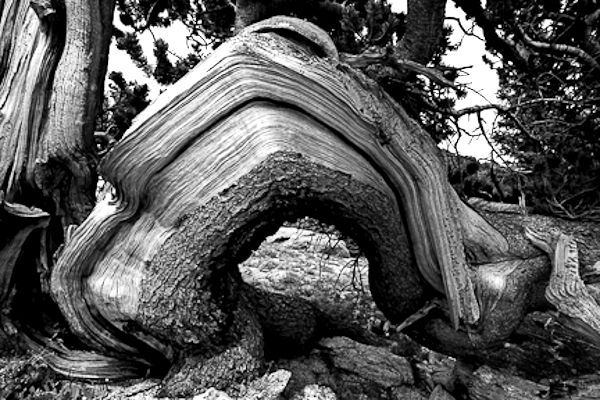
Bristelcone Pine 2
Nel corso delle estati 2008 e 2009, il fotografo americano George T. Engelmann si è inerpicato sulle montagne del Rocky Mountain, a 3.505 metri di altezza, alla ricerca del Rocky Mountain Bristelcone Pine, che il suo omonimo, l’eminente botanico Dr. George T. Engelmann aveva scoperto circa un secolo prima.
A questo illustre botanico sono stati conferiti importanti riconoscimenti; nel 1863 è stato uno dei cinquanta scienziati eletti dal Congresso come membro fondatore della National Academy of Sciences, è stato membro attivo della American Academy of Arts and Sciences e uno dei dodici membri fondatori della Accademia delle Scienze di St. Louis. È inoltre il “padre scientifico” del Missouri Botanical Garden di St. Louis, realizzato nel 1859.
Nonostante non ci sia apparentemente alcuna lontana parentela, in occasione del 200° compleanno del dottore in botanica Engelmann, il fotografo Engelmann si è sentito in dovere di onorare il suo nome e il suo lavoro, come egli stesso racconta, rendendogli omaggio con queste immagini che illustrano le sue importanti scoperte.
Si può dire che questo lavoro sia il risultato di un insieme di coincidenze. |
|
During the summer seasons of 2008 and 2009, the American photographer George T. Engelmann climbed up the Rocky Mountains to 3,505 meters searching for the Rocky Mountain Bristlecone Pine his homonymous, the eminent botanist Dr. George T. Engelmann identified more than a century before.
To this illustrious botanist important acknowledgements have been conferred; in 1863 he is as a matter of fact one of the fifty scientists elected by the Congress as a member founder of the National Academy of Sciences, he has been active member of the American Academy of Arts and Sciences and one of the twelve founding members of the Academy of Sciences of St. Louis. He is the “scientific father” of the Missouri Botanical Garden in St. Louis, established in 1859.
Even though there is no apparent long distant family relation, on occasion of the 200 birthday of the botanic Doctor Engelmann, the photographer Engelmann felt the duty to honor his name and his work, as he himself recounts, giving him tribute with images to illustrate his important discoveries.
It could be said that this work is the result of a bunch of coincidences |
  
Bristelcone Pine 1 left alone
La prima coincidenza, come è stato detto prima, è nei nomi. La seconda, ma non secondaria, è l’incontro e lo stimolo di Hal D. Gould, Maestro Fotografo e fondatore di una delle gallerie di arte fotografica più importanti degli stati Uniti, la Camera Obscura di Denver, il quale già precedentemente aveva fotografato il Rocky Mountain Bristelcone Pine.
L’indubbio fascino di questo albero deriva dal suo essere indomabile e dall’essere sopravvissuto nei secoli, essendo oggi il più antico essere vivente sulla Terra |
|
The first coincidence, as we have pointed it out, is the name. The second, no less important, is the encounter and the stimulus of Hal D. Gould, Master Photographer and founder of one of the most prestigious fine-art photography gallery in the United States of America, the Denver’s Camera Obscura, who had previously photographed the Rocky Mountain Bristlecone Pine.
The undaunted fascination of this tree comes from its indomitable being and from its centuries of survival, being today the oldest living thing on the earth. |
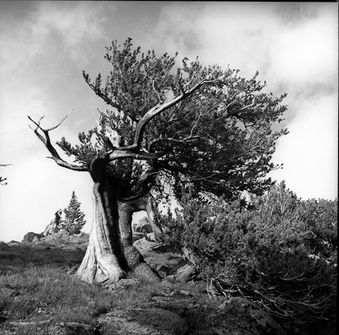  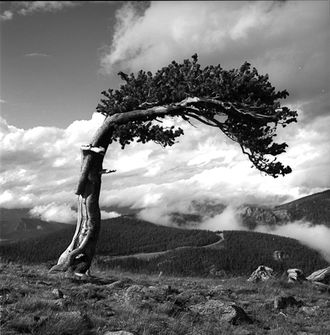
diva blowing in the wind
La fotografia di Engelmann non prevarica il soggetto piegandolo alle sue esigenze espressive, ma lo rispetta mettendo il suo obbiettivo al servizio della forza espressiva della natura. Tutti gli intrecci e i nodi degli alberi, i rami battuti dal vento, sono fotografati in un bianco e nero puro e senza compiacimenti, che ne esalta le forme quasi astratte.
Solo in un secondo momento, guardando le fotografie, le geometrie si compongono all’interno di nuove visioni che l’autore sottolinea nelle didascalie delle immagini: in “movement stopped” sembra di assistere ad una presa di lotta libera; in “diva” si percepiscono braccia aperte su cui emerge una chioma al vento; in “blowing in the wind” si sente la forza del vento che piega i rami dell’albero. È la forza della natura che si esprime, così come si esprime la forza del tempo in “frozen in time” e “left alone”. |
|
The photography of Engelmann doesn’t infringe on the subject bending it to fit its expressive needs, but he treats it with respect placing his lense to the service of the expressive strength of nature. All the interweaving and knots of the trees, the branches trodden by the winds, are photographed in pure black and white and without gratification, that it exults the almost abstract forms.
Only afterwards, looking at the photos, the geometries come together inside new visions that the author underlines in the caption about the images: in “movement stopped” it seems to be part of a round of wrestling; in “diva” one can perceive open arms on which emerges hair in the wind; in “blowing in the wind” one feels the power of the wind bending the branches of the tree. It is the power of nature expressing itself, just as the power of time expresses itself in “frozen in time” and “left alone.” |
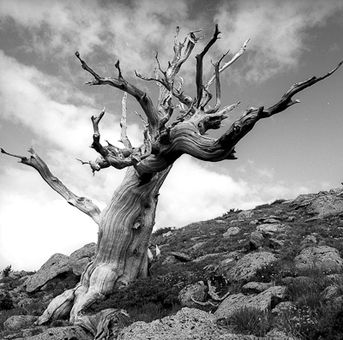  
frozen in time movement stopped
| Le fotografie di Engelmann hanno il merito di ricondurci, come esseri umani, alla nostra reale dimensione di piccola presenza in uno scenario dove non si può che assistere ad uno spettacolo grandioso e ci rammentano che natura è un concetto troppo profondo, e tempo una dimensione troppo grande, perché noi possiamo riuscire a concepirli veramente. |
|
The photography of Engelmann has the merit to take us back, as human beings, to a real dimension of small presence in a setting where we cannot but to assist a grandiose spectacle, and to keep in mind that nature is a profound concept, and time a dimension too large, for us to be able to try to understand as they are. |
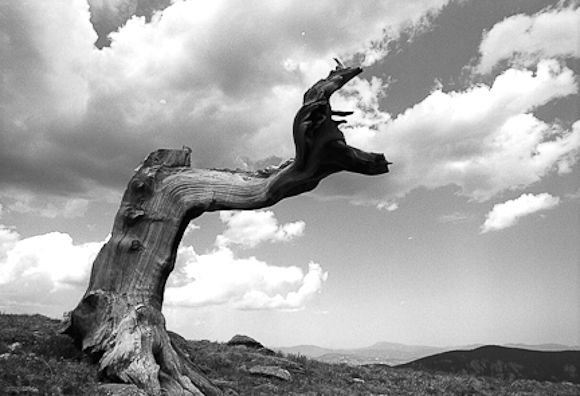
Bristelcone Pine 3
|